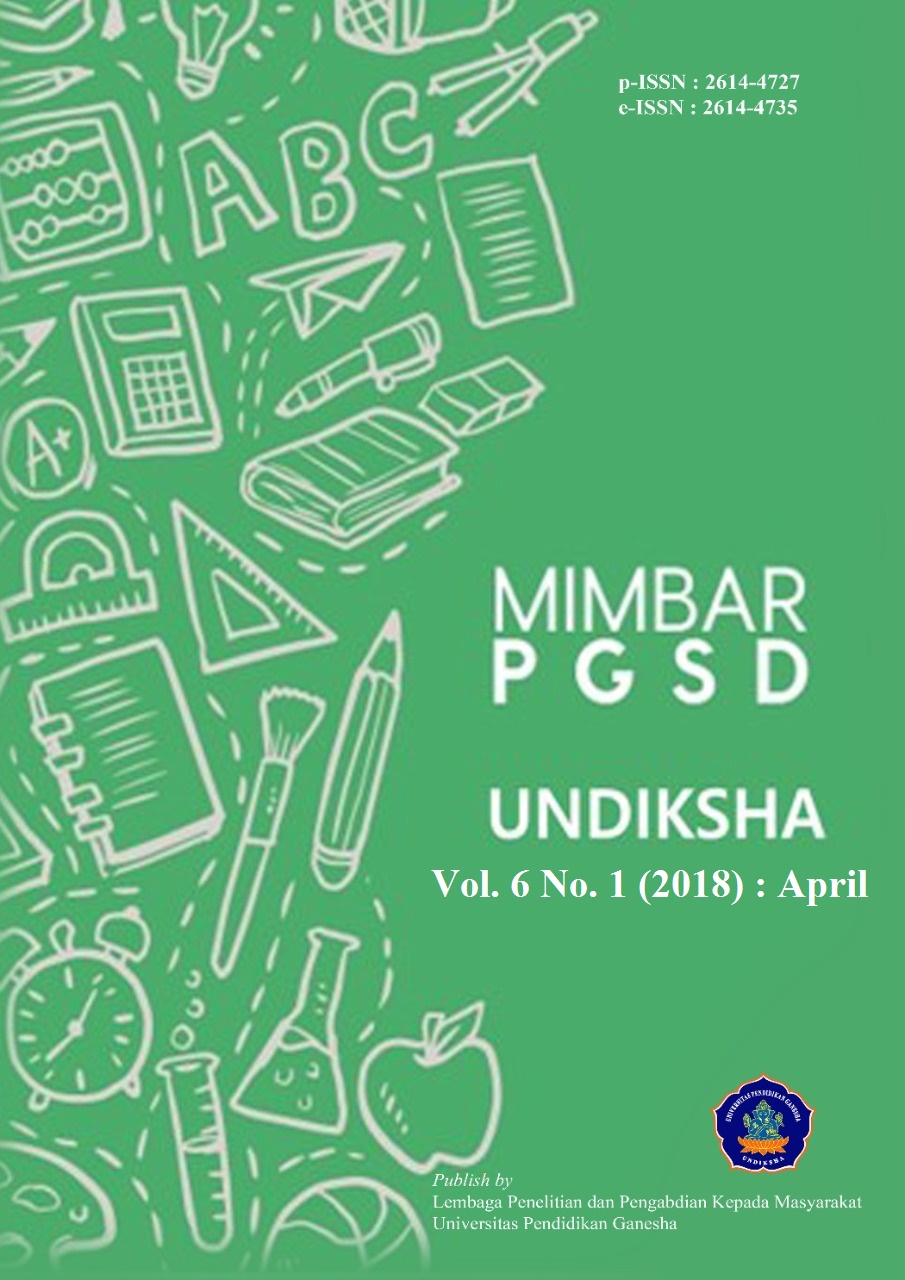PENERAPAN MODEL PEMBELAJARAN KOOPERATIF TIPE NUMBERED HEAD TOGETHER(NHT) UNTUK MENINGKATKAN KEMAMPUAN SISWA DALAM MENYELESAIKAN SOAL CERITA PADA MATA PELAJARAN MATEMATIKA KELAS V
DOI:
https://doi.org/10.23887/jjpgsd.v6i1.13107Abstract
Tujuan penelitian ini adalah untuk mengetahui peningkatan kemampuan siswa dalam menyelesaikan soal cerita melalui model pembelajaran kooperatif tipe numbered head together (NHT) pada siswa kelas V SD NO 4 Sangsit Kecamatan Sawan Kabupaten Buleleng Tahun Pelajaran 2016/2017. Penelitian merupakan penelitian tindakan kelas yang dilaksanakan dalam dua siklus. Setiap siklus terdiri dari tahap perencanaan, pelaksanaan tindakan, observasi, evaluasi, serta refleksi.Subjek penelitian ini adalah siswa kelas V di SD NO 4 Sangsit Tahun Pelajaran 2016/2017, dengan jumlah siswa sebanyak 25 orang. Objek penelitian ini adalah kesulitan siswa dalam menyelesaikan soal cerita kelas 4 di SD NO 4 Sangsit Tahun Pelajaran 2016/2017. Pengumpulan data dalam penelitian ini dilakukan dengan metode evaluasi. pada siklus I kemampuan menyelesaikan soal cerita adalah 64,97%. Presentase menyelesaikan soal cerita yang diperoleh pada siklus 1 berada pada katagori kurang. pada siklus II kemampuan menyelesaikan sola cerita adalah 88,63%. presentase kemampuan menyelesaikan soal cerita pada pertemuan II berada pada kategori baik. berdasarkan hasil penelitian tersebut dapat di simpulkan bahwa Penerapan Model Pembelajaran Kooperatif tipe Numbered Head Together (NHT) Dapat meningkatkan kemampuan siswa dalam menyelesaikan soal cerita pada mata pelajaran matematika kelas V SD No. 4 Sangsit Kecamatan Sawan Kabupaten Buleleng Tahun Pelajaran 2016/2017.Kata Kunci : pembelajarann kooperatif tipe numbered head together, kemampuan siswa
The purpose of this study was to determine the improvement of students' ability in solving the story through cooperative learning model Numbered Head Together (NHT) in Class V SD No. 4 Sangsit District of SawanBuleleng in the academic year 2016/2017. This research is a classroom action research conducted in two cycles. Each cycle consisted of planning, action, observation, evaluation, and revleksi. The subjects were fifth grade students in elementary school No. 4 Sangsit the school year 2016/2017, the number of students as many as 25 people. The object of this research is the difficulty in solving story student fifth grade elementary school No. 4 Sangsit in academic year 2016/2017. Collecting data in this study conducted by the method of evaluation. In the first cycle the ability to solve problems is the story of 64.97%. Percentage ability to solve word problems that obtained in the first cycle in the category less. In the second cycle the ability to solve problems is the story of 88.63%. Percentage ability to solve word problems gained at the meeting II are in either category. Based on these results it can be concluded that the application of Cooperative Learning Model Numbered Head Together (NHT) Can Enhance Students Ability In Problem Solving Math Lesson Story In Class V SD No. 4 Sangsit District of SawanBuleleng in the academic year 2016/2017.
keyword : Numbered head of cooperative learning together, the ability of students
Published
2018-01-25
How to Cite
., B. H., ., D. I. D. K. T. M., & ., D. I. N. M. M. (2018). PENERAPAN MODEL PEMBELAJARAN KOOPERATIF TIPE NUMBERED HEAD TOGETHER(NHT) UNTUK MENINGKATKAN KEMAMPUAN SISWA DALAM MENYELESAIKAN SOAL CERITA PADA MATA PELAJARAN MATEMATIKA KELAS V. MIMBAR PGSD Undiksha, 6(1). https://doi.org/10.23887/jjpgsd.v6i1.13107
Issue
Section
Articles
License
Authors who publish with the Mimbar PGSD Undiksha agree to the following terms:
- Authors retain copyright and grant the journal the right of first publication with the work simultaneously licensed under a Creative Commons Attribution License (CC BY-SA 4.0) that allows others to share the work with an acknowledgment of the work's authorship and initial publication in this journal.
- Authors are able to enter into separate, additional contractual arrangements for the non-exclusive distribution of the journal's published version of the work (e.g., post it to an institutional repository or publish it in a book), with an acknowledgment of its initial publication in this journal.
- Authors are permitted and encouraged to post their work online (e.g., in institutional repositories or on their website) prior to and during the submission process, as it can lead to productive exchanges, as well as earlier and greater citation of published work. (See The Effect of Open Access)













